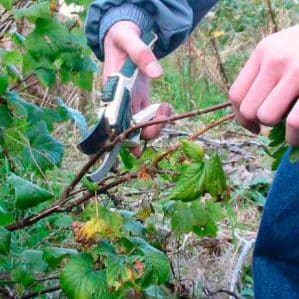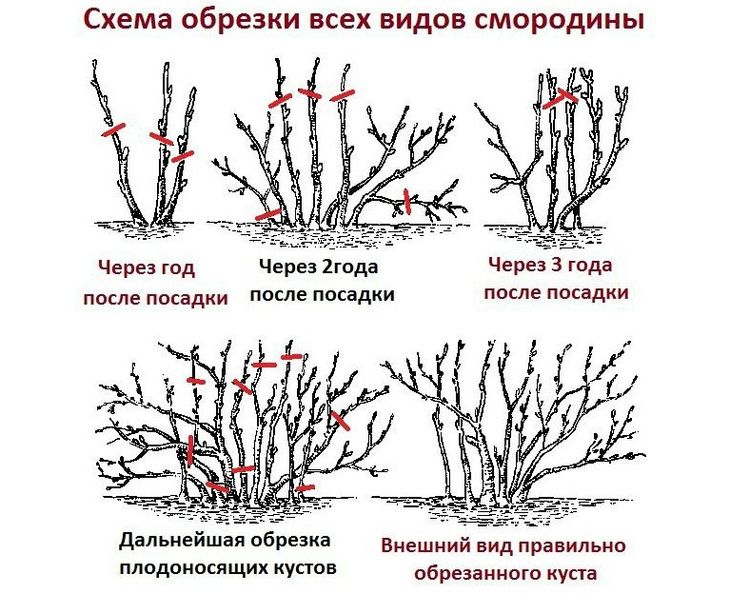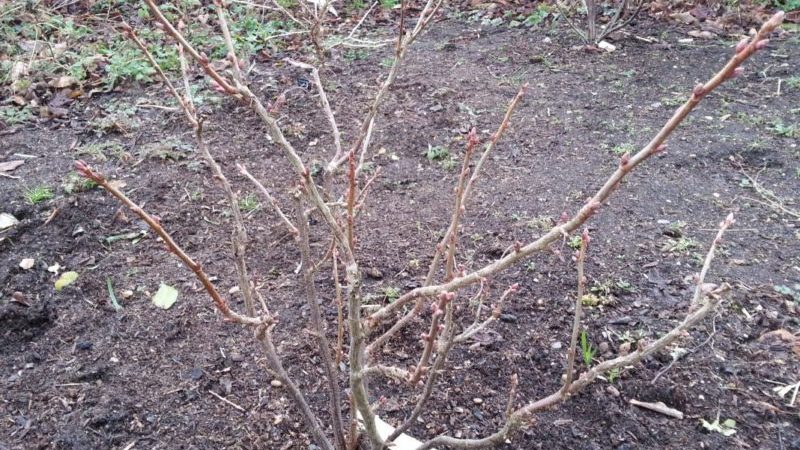A guide to proper autumn pruning of currants for beginner gardeners
The list of autumn garden work includes pruning currants. Proper preparation of the bush for the winter season affects further productivity. Before starting the procedure, they study the pruning technology, the optimal timing for its implementation, and the rules for caring for the bush after mechanical impact. If the recommendations are followed exactly, pruning currants in the fall will not be a problem for beginning gardeners.
Why prune currants in the fall, what does it give?
During the spring-summer season, the currant bush actively grows and bears fruit. In autumn, the movement of sap stops. The period of shedding leaves signals that it is time to prune. At this time, the plant experiences minimal stress from shortening the shoots. Autumn pruning of currants allows you to prepare the bushes for winter.

Is pruning necessary?
Pruning currants is a mandatory procedure. On bushes, fruit buds appear only on branches up to 5 years old. Old branches are barren; every year they dry out more and more and interfere with the normal growth of young shoots. They are cut out. Sick and pest-affected shoots must also be removed.
The autumn agrotechnical procedure heals the plant, increases the size of the berries, improves their taste and productivity. During the procedure, the bush is given the correct shape.
Optimal timing of the procedure
The autumn procedure is carried out immediately after leaf fall and the end of sap flow. This usually happens at the end of October - mid-November, before the onset of frost.
The timing of pruning varies depending on the region of growth. In the Moscow region, frosts begin in mid-November, so the procedure is carried out in the last days of October. In Siberia, sudden temperature changes often occur in the fall, so experienced gardeners recommend holding an autumn event in mid-September.
When is it better to prune - in spring or autumn?
The best period for pruning a fruiting bush is autumn. During the season, the bush grows actively, young shoots appear on it. Some produce a lot of berries, others do not bear fruit. Unproductive branches take nutrients from the bush and create shade for fruiting shoots. These branches are removed after the end of the season. In spring, you can make a mistake in choosing productive branches.
Types of pruning
Young currant bushes grow quickly - after 2 years they grow and begin to bear fruit. After 4-5 years, the bush becomes overgrown, loses its shape, and the berries become smaller. The plant needs adjustment. There are several types of pruning. Depending on the purpose, it is divided into formative, rejuvenating, sanitary.
Formative
To achieve high yields, the shrub is formed by pruning. It is necessary for the proper development of the plant, preventing thickening, and creating better conditions for the growth of new shoots. Pruning of a developed, fruit-bearing plant is carried out annually.
Reference. A fruiting bush should have 12-13 branches of different ages.
To form such a plant, three-year-old bushes are left with 3-4 developed and evenly spaced branches.The purpose of the formation is to create a bush with a wide base for lighting and ventilation of the central branches. Plant thickening can lead to the formation of powdery mildew. In dense bushes, the berries ripen only at the tops of the stems.

Subsequent pruning leaves behind strong young shoots that grow closer to the edge of the bush. At the same time, the central shoots are removed, expanding the base of the bush. Weakened, excess, diseased shoots inclined to the ground must also be removed.
Branches older than 5-6 years stop bearing fruit and are also cut out.
Rejuvenating
Anti-aging pruning is carried out to increase the life expectancy of the shrub. It is done after 8 years of plant life - at this age the yield is low.
Attention! When carrying out the procedure, it is important to learn to distinguish annual shoots from older branches. The young shoot has no branches and is light green in color. Branches older than two years are dark brown in color and have branches.
During the rejuvenation procedure, old, dried stems are cut down to the base, dusting the cut areas with wood ash.
Anti-aging pruning of the crop can be carried out partially, over 2-3 years, or radically, at one time. The first method is used for 8-10 year old shrubs, the second - for old and diseased plants.
During partial pruning, a third of the old branches are removed. First, dry, diseased areas are cut out. The next year, remove excess, improperly growing branches. In the third year, young healthy shoots will grow in place of the removed old branches, and the fruiting of the bush will increase.
If the plant is older than 8 years, most of the branches have dried up, complete rejuvenation is carried out.In this case, all branches are cut down to the base, and the cuts are treated with wood ash. The remaining above-ground part is mulched with sawdust, straw, and peat to prevent freezing in winter. With the onset of spring, the roots are watered with “Fitosporin” and fed with organic matter, re-growing a young bush.
Sanitary
During sanitary pruning, broken and damaged branches are cut out. Remove diseased parts of the bush affected by insect pests. In case of severe damage by powdery mildew or glassworm, the stems are removed by cutting at the very base and burned. If the tops of the plant are damaged, they are cut off, capturing a small area of the healthy stem.
How to prune currants correctly
To increase the fruiting of the bush and its proper formation, the procedure is carried out before the onset of frost, when the plant enters a dormant period.
The following rules are observed:
- pruning is done only after the bush has shed all its foliage;
- the procedure is carried out in dry weather;
- For the procedure, a disinfected, sharpened instrument is used;
- do not break off branches with your hands;
- do not cut the shoot close to a healthy bud (this will lead to the death of the entire shoot), the recommended distance from the bud to the cut is 0.5 cm;
- do not leave stumps, dry branches are cut to soil level;
- branches are shortened to the nearest external bud;
- cuts are made at an angle of 45°.
Required materials and tools
All necessary tools are disinfected and sharpened. After pruning diseased branches, the tools are disinfected to prevent infection of the remaining shoots.
To hold the fall event you will need:
- pruning shears for cutting thin and medium-thick branches;
- garden knife for obtaining smooth cutting edges on thin shoots;
- a hacksaw with fine teeth to remove old thick stems;
- lopper (thanks to the long handles, it is convenient to remove hard-to-reach branches from the middle of the bush);
- brush cutter for cutting branches of various thicknesses and giving the bush the required shape;
- fan rake for collecting leaves and trimmed branches;
- gardening gloves.
Trimming diagram: step-by-step instructions

After the end of leaf fall, scheduled pruning of the bush begins. To do this, perform the following work:
- Clean the tree trunk circle from fallen leaves and weeds.
- Cut off dry and moss-covered branches.
- Cut out broken, diseased, disease- or insect-damaged parts of the plant.
- Remove branches that rest on the ground, grow deep into the bush, do not bear fruit, are short, and have immature wood.
- Thin out the central part of the bush so that the middle branches are evenly illuminated by the sun and ventilated.
- One-year growths are shortened by 5-6 cm.
- Shoots older than 5 years are cut off, 3-year-old branches are shortened.
- 5-6 of the most powerful shoots are left, the rest are removed.
After processing, all cut branches are removed, the soil around the bush is loosened, fertilize, cover with a layer of mulch.
Bush formation
To maintain the desired shape of the shrub, adjustments are made annually by pruning. Immediately after planting, the stems of the young seedling are cut off, leaving 2-3 healthy buds. At the same time, make sure that the top bud is directed to the outside of the bush. This is necessary so that the shoots form in different directions.
In the second year, 5 powerful shoots are selected, the rest are removed. In the third year, the branches of the first and second years are not touched. Select 5 new strong shoots with the correct direction of growth. Get rid of root growth.In the fourth year, the pruning pattern of the third year is repeated. In the fifth year, the bush is rejuvenated. At the same time, non-fruit-bearing branches are cut out.
As a result, a healthy fruit-bearing bush should have 15-18 branches of different ages left.
Reference. Some gardeners create fancy shrub shapes, for example, in the form of a pyramid or vase. For decoration, the standard method of plant formation is used.
Trimming Features
Shrub pruning varies depending on the age and variety of crop.

Young currant
To prune young currants, check the condition of the shoots that have formed during the season. If the branches have grown small and thin (less than 0.6 mm), they are cut short, leaving 3 buds above the ground. Of the grown strong, thick shoots, 3-4 of the longest and most powerful shoots are left, the rest are cut out at the base.
The green tops of the stems are shortened - they will freeze in cold weather. Only woody stems are left for the winter.
Old
An old currant bush aged 8-13 years is rejuvenated using thinning:
- Cut out all dry, broken, diseased and insect-damaged parts of the plant.
- Remove shoots that rest on the ground and interfere with the growth of properly positioned branches.
- Weak, non-fruit-bearing branches on which growth does not form are cut to the ground.
Black/white/red
Black currants are pruned more often than red and white ones. The growth of shoots in the black variety occurs more actively, fruiting occurs in 3-4 years. White and red currants bear full fruit on 6-7-year-old branches, but if the growth on older branches during the season is less than 15 cm, these branches are disposed of.
Black currants begin to rejuvenate after 5 years of life, red currants - after 8 years. Shortening of the apical shoots is carried out only on the black variety; in white and red currants, the fruits are formed on the upper branches, so they are not touched. White currant rejuvenation is carried out at the age of 13-15 years.
Processing slices
Processing of cuts prevents infection from penetrating into plant tissues damaged during pruning. Before processing, wait until the juice stops secreting and the cut dries.
Garden varnish is applied to the sawdust smoothed with a garden knife and cleared of sawdust. To prepare the product, take 6 parts rosin, 3 parts wax, 1 part turpentine and 2 parts propolis. Melt propolis and wax in a water bath and add rosin. Stir and bring to a boil. Then cool and mix with turpentine. The resulting mass is applied to the sections.
Further care
How to care for bushes after pruning? Before wintering, the soil around the plant is dug up and fertilizers are applied, since during fruiting the bush has spent all its strength. Phosphorus-potassium fertilizers are used for fertilizing. Phosphorus and potassium promote the growth and strengthening of the root system, increase the plant's frost resistance, and improve immunity.
Attention! Before applying fertilizers, water the soil with water to avoid burning the roots. Apply 10-15 liters of water to each bush.
Prepare the composition: 30-35 g of ammophos and 1 glass of ash are diluted in 10 liters of water. For one plant, use 2-3 liters of the resulting solution.
For prevention, bushes are treated with Karbofos to prevent pest attacks.
Preparing for winter
In regions where snowless winters are usually accompanied by severe frosts, the trunk circle of one- and two-year-old plants is insulated with mulch from sawdust or spruce branches with a layer of 8-10 cm. For an adult plant, this procedure is not necessary.
In areas characterized by heavy snowfall, gardeners tie the bushes with rope so that the thick layer of snow lying on the bush does not break off the branches. To preserve the currant bush, wrap it in a circle with a strong rope, pulling all the branches to the central part of the bush, and securely fix the rope. With the onset of spring, the rope is removed.
Read also:
The best ways to dry blackcurrants at home.
A step-by-step guide to fermenting currant leaves for tea at home.
How and when to collect currant and raspberry leaves for drying for the winter.
Conclusion
Autumn pruning of currants is carried out regardless of age and variety. By following the advice, novice gardeners can also carry out the procedure. Compliance with the scheme and rules of the autumn event increases the crop yield and prolongs the fruiting age of the bush.